Effects of Organic, Organomineral, and Mineral Fertilization on Soil Macronutrients in Chrysanthemum Cultivar Singelo Cultivation
Abstract
1. Introduction
2. Materials and Methods
2.1. Characterization of the Study Area
2.2. Experimental Design and Treatments
2.3. Experimental Procedures and Management
2.3.1. Soil Preparation, Treatment Application, and Sowing
2.3.2. Irrigation Management
2.4. Analyzed Variables
2.5. Statistical Analysis
3. Results
4. Discussion
5. Conclusions
- Soil fertilized with fertilizers containing wood ash provided high levels of primary and secondary macronutrients;
- Organomineral fertilizer is an alternative fertilizer for reducing the volume of synthetic fertilizer and wood ash used, in addition to providing high levels of macronutrients in the Oxisol, allowing a second cropping cycle without the need to maintain soil fertility, contributing to sustainable agriculture and the circular economy;
- There is no need for liming when using fertilizers containing wood ash;
- The application form of incorporated wood ash showed better results in relation to the content of primary and secondary macronutrients in Oxisol;
- Future studies are needed to investigate the long-term impacts on crop yields and soil nutrient availability, and field-scale validations are needed to assess the practical applications of these organomineral fertilizers in various agricultural environments.
Supplementary Materials
Author Contributions
Funding
Data Availability Statement
Acknowledgments
Conflicts of Interest
References
- de Lima, F.R.D.; Silva, A.O.; Amorim, H.C.S.; Figueredo, E.S.S.; Carneiro, R.M.C.; Jara, M.S.; Carneiro, M.A.C.; Guilherme, L.R.G. Agronomic and Environmental Aspects of Organo-Mineral Fertilizers Produced with a by-Product of the Intermediate Process of Tanning. Front. Agron. 2023, 5, 1215448. [Google Scholar] [CrossRef]
- Lisowska, A.; Filipek-Mazur, B.; Komorowska, M.; Niemiec, M.; Bar-Michalczyk, D.; Kuboń, M.; Tabor, S.; Gródek-Szostak, Z.; Szeląg-Sikora, A.; Sikora, J.; et al. Environmental and Production Aspects of Using Fertilizers Based on Waste Elemental Sulfur and Organic Materials. Materials 2022, 15, 3387. [Google Scholar] [CrossRef] [PubMed]
- Velenturf, A.P.M.; Archer, S.A.; Gomes, H.I.; Christgen, B.; Lag-Brotons, A.J.; Purnell, P. Circular Economy and the Matter of Integrated Resources. Sci. Total Environ. 2019, 689, 963–969. [Google Scholar] [CrossRef] [PubMed]
- Meneghetti, L.A.M.; Bonfim-Silva, E.M.; da Silva, T.J.A.; Duarte, T.F.; Pinheiro, E.A.R.; de Oliveira, J.R. Biomass and Water Use Efficiency of Chrysanthemum under Organic, Mineral, and Organomineral Fertilization. Rev. Bras. Eng. Agríc. Ambient. 2023, 27, 505–511. [Google Scholar] [CrossRef]
- de Oliveira, N.P.R.; Bonfim-Silva, E.M.; da Silva, T.J.A.; da Silva, P.F.; da Silva Rocha, R.A.; Meneghetti, L.A.M.; Custódio, A.S.C.; Guimarães, S.L.; Duarte, T.F.; Koetz, M. Effects of Fertilization Types and Base Saturation on the Growth and Water Productivity in Panicum Maximum Cv. BRS Zuri. Agriculture 2023, 13, 1872. [Google Scholar] [CrossRef]
- Jian, C.; Hamamoto, T.; Inoue, C.; Chien, M.-F.; Naganuma, H.; Mori, T.; Sawada, A.; Hidaka, M.; Setoyama, H.; Makino, T. Effects of Wood Ash Fertilizer on Element Dynamics in Soil Solution and Crop Uptake. Agronomy 2025, 15, 1097. [Google Scholar] [CrossRef]
- Hamidi, N.H.; Ahmed, O.H.; Omar, L.; Ch’ng, H.Y. Soil Nitrogen Sorption Using Charcoal and Wood Ash. Agronomy 2021, 11, 1801. [Google Scholar] [CrossRef]
- Paramisparam, P.; Ahmed, O.H.; Omar, L.; Ch’ng, H.Y.; Johan, P.D.; Hamidi, N.H. Co-Application of Charcoal and Wood Ash to Improve Potassium Availability in Tropical Mineral Acid Soils. Agronomy 2021, 11, 2081. [Google Scholar] [CrossRef]
- European Commission. Regulation (EU) 2019/1009 OF THE European Parliament and of the Council of 5 June 2019 Laying down Rules on the Making Available on the Market of EU Fertilising Products and Amending Regulations (EC) No 1069/2009 and (EC) No 1107/2009 and Repealing Regulation (EC) No 2003/2003; European Commission: Brussels, Belgium, 2019; pp. 1–114. [Google Scholar]
- Bonfim-Silva, E.M.; Nonato, J.J.; Simeon, B.G.; Alves, R.D.S.; Silva, M.I.P.; Silva, T.J.A. Mung Bean Shoot and Root Growth under Wood Ash as a Soil Acidity Neutralizer and Fertilizer. Int. J. Veg. Sci. 2021, 27, 303–314. [Google Scholar] [CrossRef]
- Araújo, L.M.; Andrade, F.R.; da Silva, K.F.; Lima, E.d.N.; Lanssanova, L.R.; Marostega, T.N.; Gil, R.L.; Silva, S.L.d.; Ferreira, K.R. Application of Doses of Soil Conditioning Associated with Mineral and Organic Fertilization in Lettuce Cultivation. Res. Soc. Dev. 2020, 9, e74091110375. [Google Scholar] [CrossRef]
- Bouhia, Y.; Hafidi, M.; Ouhdouch, Y.; Boukhari, M.M.; Mphatso, C.; Zeroual, Y.; Lyamlouli, K. Conversion of Waste into Organo-Mineral Fertilizers: Current Technological Trends and Prospects. Rev. Environ. Sci. Biotechnol. 2022, 21, 425–446. [Google Scholar] [CrossRef]
- de Oliveira, C.L.; Tavares, R.L.M.; de Assis, R.L.; Cantão, V.C.G.; Sitta, C. Nutrient Dynamics with Application of Humic Substances and Liming in Irrigated Soil Filled Columns. Semin. Cienc. Agrar. 2021, 42, 1567–1578. [Google Scholar] [CrossRef]
- dos Santos, H.G.; Jacomine, P.K.T.; dos Anjos, L.H.C.; de Oliveira, V.Á.; Lumbreras, J.F.; Coelho, M.R.; de Almeida, J.A.; de Araújo Filho, J.C.; de Oliveira, J.B.; Cunha, T.J.F. Sistema Brasileiro de Classificação de Solos, 5th ed.; Embrapa: Brasília, DF, Brazil, 2018; ISBN 9788570358004. [Google Scholar]
- Soil Survey Staff. Keys to Soil Taxonomy, 13th ed.; USDA Natural Resources Conservation Service: Washington, DC, USA, 2022.
- Alcarde, J.C. Manual de Análise de Fertilizantes; FEALQ: Piracicaba, SP, Brazil, 2009. [Google Scholar]
- Alcarde, J.C.; Rodela, A.A. Avaliação Química de Corretivos de Acidez Para Fins Agrícolas: Uma Nova Proposição. Sci. Agric. 1996, 53, 211–216. [Google Scholar] [CrossRef]
- Barbosa, J.G.; Grossi, J.A.S.; Borém, A. Crisântemo: Do Plantio à Colheita; UFV, CEAD: Viçosa, MG, Brazil, 2019. [Google Scholar]
- Bär, C.; Koetz, M.; Bonfim-Silva, E.M.; da Silva, T.J.A. Influence of Water Availability and Wood Ash Doses on the Productive Characteristics and Water Usage of Potted Gerbera. J. Exp. Agric. Int. 2018, 23, 1–9. [Google Scholar] [CrossRef]
- Ribeiro, A.C.; Guimarães, P.T.G.; Alvarez, V.V.H. Recomendações Para o Uso de Corretivos e Fertilizantes em Minas Gerais, 1st ed.; Comissão de Fertilidade do Solo do Estado de Minas Gerais—CFSEMG: Viçosa, MG, Brazil, 1999. [Google Scholar]
- Teixeira, A.J. A Cultura Do Crisântemo de Corte; EMATER-RIO: Nova Friburgo, RJ, Brazil, 2004.
- Bonfim-Silva, E.M.; Monteiro, F.A.; da Silva, T.J.A. Nitrogênio e enxofre na produção e no uso de água pelo capim-braquiária em degradação. R. Bras. Ci. Solo 2007, 31, 309–317. [Google Scholar] [CrossRef]
- Teixeira, P.C.; Donagemma, G.K.; Fontana, A.; Teixeira, W.G. Manual de Métodos de Análise de Solo, 3rd ed.; Teixeira, P.C., Donagemma, G.K., Fontana, A., Teixeira, W.G., Eds.; Embrapa: Brasília, DF, Brazil, 2017; ISBN 9788570357717. [Google Scholar]
- Andrade, J.C.; Friguetto, S.R.; Baccan, N.; Cantarella, H.; Bataglia, O.C. Determinação Turbidimétrica de Sulfato Em Solos Mediante Análise Por Injeção Em Fluxo. Rev. Bras. Cienc. Solo 1990, 14, 119. [Google Scholar]
- Ferreira, D.F. SISVAR: A Computer Analysis System to Fixed Effects Split Plot Type Designs. Rev. Bras. Biom. 2019, 37, 529–535. [Google Scholar] [CrossRef]
- R Core Team. R: A Language and Environment for Statistical Computing; R Foundation for Statistical Computing: Viena, Austria, 2018. [Google Scholar]
- van Raij, B.; Cantarella, H.; Quaggio, J.A.; Furlani, A.M.C. Boletim Técnico 100: Recomendações de Adubação e Calagem Para o Estado de São Paulo, 2nd ed.; van Raij, B., Cantarella, H., Quaggio, J.A., Furlani, A.M.C., Eds.; Instituto Agronômico/Fundação IAC: Campinas, SP, Brazil, 1997.
- Jansone, B.; Samariks, V.; Okmanis, M.; Kļaviņa, D.; Lazdiņa, D. Effect of High Concentrations of Wood Ash on Soil Properties and Development of Young Norway Spruce (Picea abies (L.) Karst) and Scots Pine (Pinus sylvestris L.). Sustainability 2020, 12, 9479. [Google Scholar] [CrossRef]
- Cruz, N.; Avellan, A.; Ruivo, L.; Silva, F.C.; Römkens, P.F.A.M.; Tarelho, L.A.C.; Rodrigues, S.M. Biomass Ash-Based Soil Improvers: Impact of Formulation and Stabilization Conditions on Materials’ Properties. J. Clean. Prod. 2023, 391, 136049. [Google Scholar] [CrossRef]
- Lopes, J.I.; Gonçalves, A.; Brito, C.; Martins, S.; Pinto, L.; Moutinho-Pereira, J.; Raimundo, S.; Arrobas, M.; Rodrigues, M.Â.; Correia, C.M. Inorganic Fertilization at High N Rate Increased Olive Yield of a Rainfed Orchard but Reduced Soil Organic Matter in Comparison to Three Organic Amendments. Agronomy 2021, 11, 2172. [Google Scholar] [CrossRef]
- Bonfim-Silva, E.M. Cinza Vegetal e Biochar Na Agricultura; Bonfim-silva, E.M., Ed.; Uniedusul: Maringá, PR, Brazil, 2020. [Google Scholar]
- Rolka, E.; Żołnowski, A.C.; Wyszkowski, M.; Zych, W.; Skorwider-Namiotko, A. Wood Biomass Ash (WBA) from the Heat Production Process as a Mineral Amendment for Improving Selected Soil Properties. Energies 2023, 16, 5110. [Google Scholar] [CrossRef]
- Elliott, A.; Mahmood, T.; Kamal, A. Boiler Ash Utilization in the Canadian Pulp and Paper Industry. J. Environ. Manag. 2022, 319, 115728. [Google Scholar] [CrossRef]
- Taiz, L.; Zeiger, E.; Møller, I.M.; Murphy, A. Fundamentos de Fisiologia Vegetal, 6th ed.; Artmed, E-pub: Porto Alegre, RS, Brazil, 2021. [Google Scholar]
- Johan, P.D.; Ahmed, O.H.; Omar, L.; Hasbullah, N.A. Phosphorus Transformation in Soils Following Co-Application of Charcoal and Wood Ash. Agronomy 2021, 11, 2010. [Google Scholar] [CrossRef]
- Hossain, M.B.; Khan, M.H.R.; Khanom, S.; Hossain, S.A. Amelioration of Soil Acidity by the Application of Maize Straw Ash in Mixed Soil. Dhaka Univ. J. Biol. Sci. 2021, 30, 207–219. [Google Scholar] [CrossRef]
- Pereira, D.S.; da Costa, Y.K.S.; de Carvalho, L.B. O Elemento P: Formas e Dinâmica Em Solos Tropicais. Rev. Agron. Bras. 2021, 5, 1–4. [Google Scholar] [CrossRef]
- Johansen, J.L.; Nielsen, M.L.; Vestergård, M.; Mortensen, L.H.; Cruz-Paredes, C.; Rønn, R.; Kjøller, R.; Hovmand, M.; Christensen, S.; Ekelund, F. The Complexity of Wood Ash Fertilization Disentangled: Effects on Soil PH, Nutrient Status, Plant Growth and Cadmium Accumulation. Environ. Exp. Bot. 2021, 185, 104424. [Google Scholar] [CrossRef]
- Azan, S.S.E.; Yan, N.D.; Celis-Salgado, M.P.; Arnott, S.E.; Rusak, J.A.; Sutey, P. Could a Residential Wood Ash Recycling Programme Be Part of the Solution to Calcium Decline in Lakes and Forests in Muskoka (Ontario, Canada)? Facets 2019, 4, 69–90. [Google Scholar] [CrossRef]
- Cremer, M.; Prietzel, J. Soil Acidity and Exchangeable Base Cation Stocks under Pure and Mixed Stands of European Beech, Douglas Fir and Norway Spruce. Plant Soil 2017, 415, 393–405. [Google Scholar] [CrossRef]
- Hao, T.; Zhu, Q.; Zeng, M.; Shen, J.; Shi, X.; Liu, X.; Zhang, F.; de Vries, W. Impacts of Nitrogen Fertilizer Type and Application Rate on Soil Acidification Rate under a Wheat-Maize Double Cropping System. J. Environ. Manag. 2020, 270, 110888. [Google Scholar] [CrossRef]
- Baloch, S.B.; Ali, S.; Bernas, J.; Moudrý, J.; Konvalina, P.; Mushtaq, Z.; Murindangabo, Y.T.; Onyebuchi, E.F.; Baloch, F.B.; Ahmad, M.; et al. Wood Ash Application for Crop Production, Amelioration of Soil Acidity and Contaminated Environments. Chemosphere 2024, 357, 141865. [Google Scholar] [CrossRef]
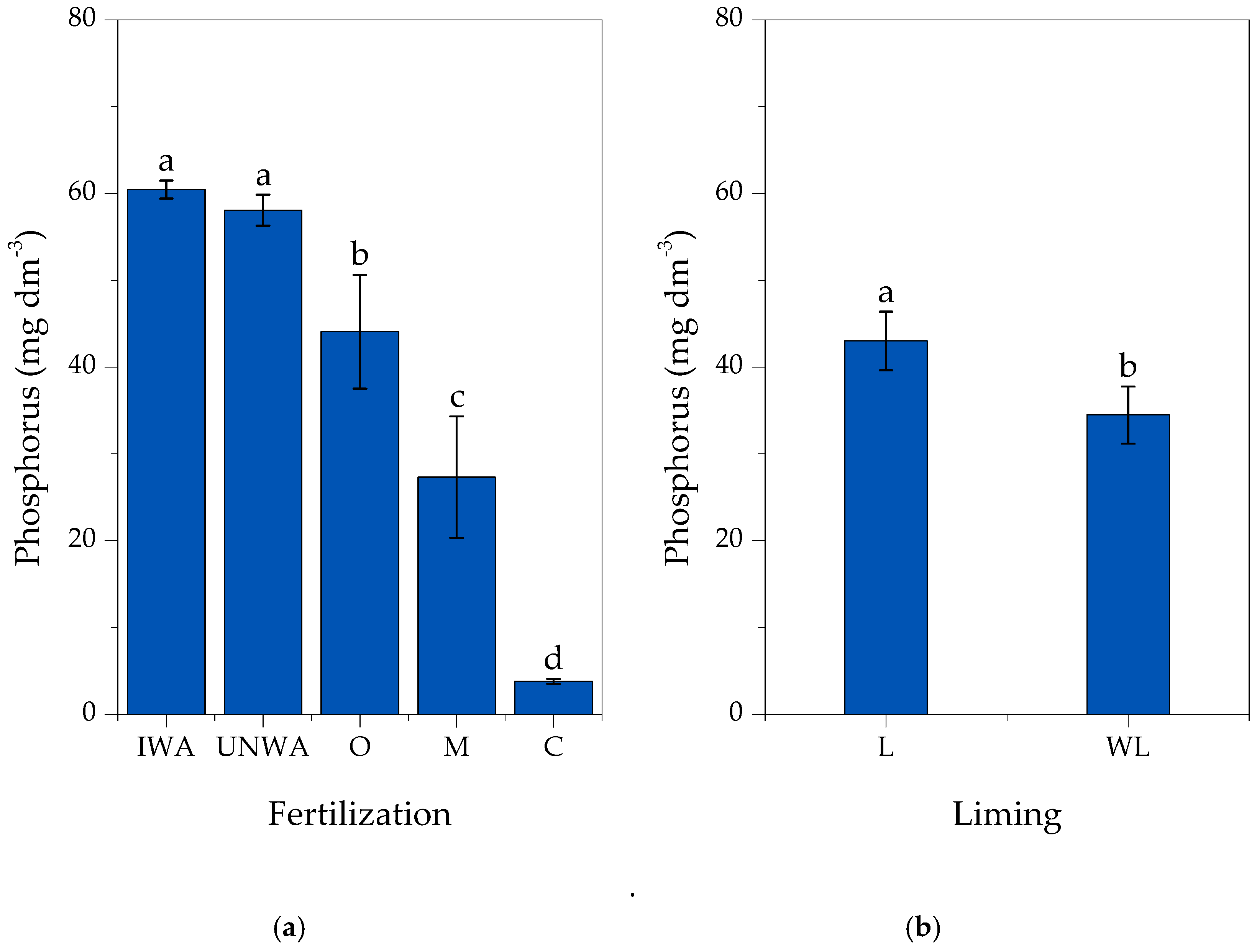
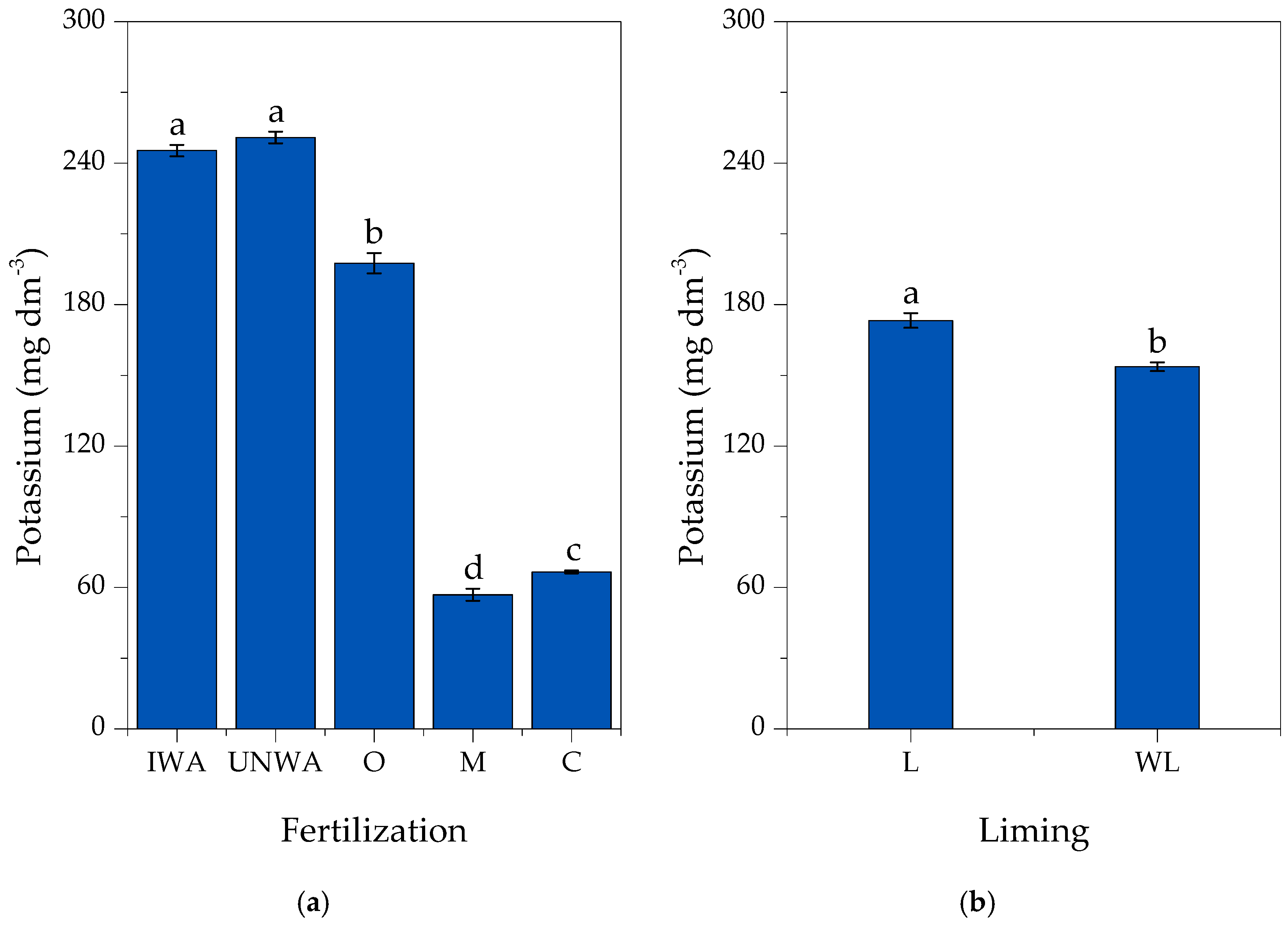
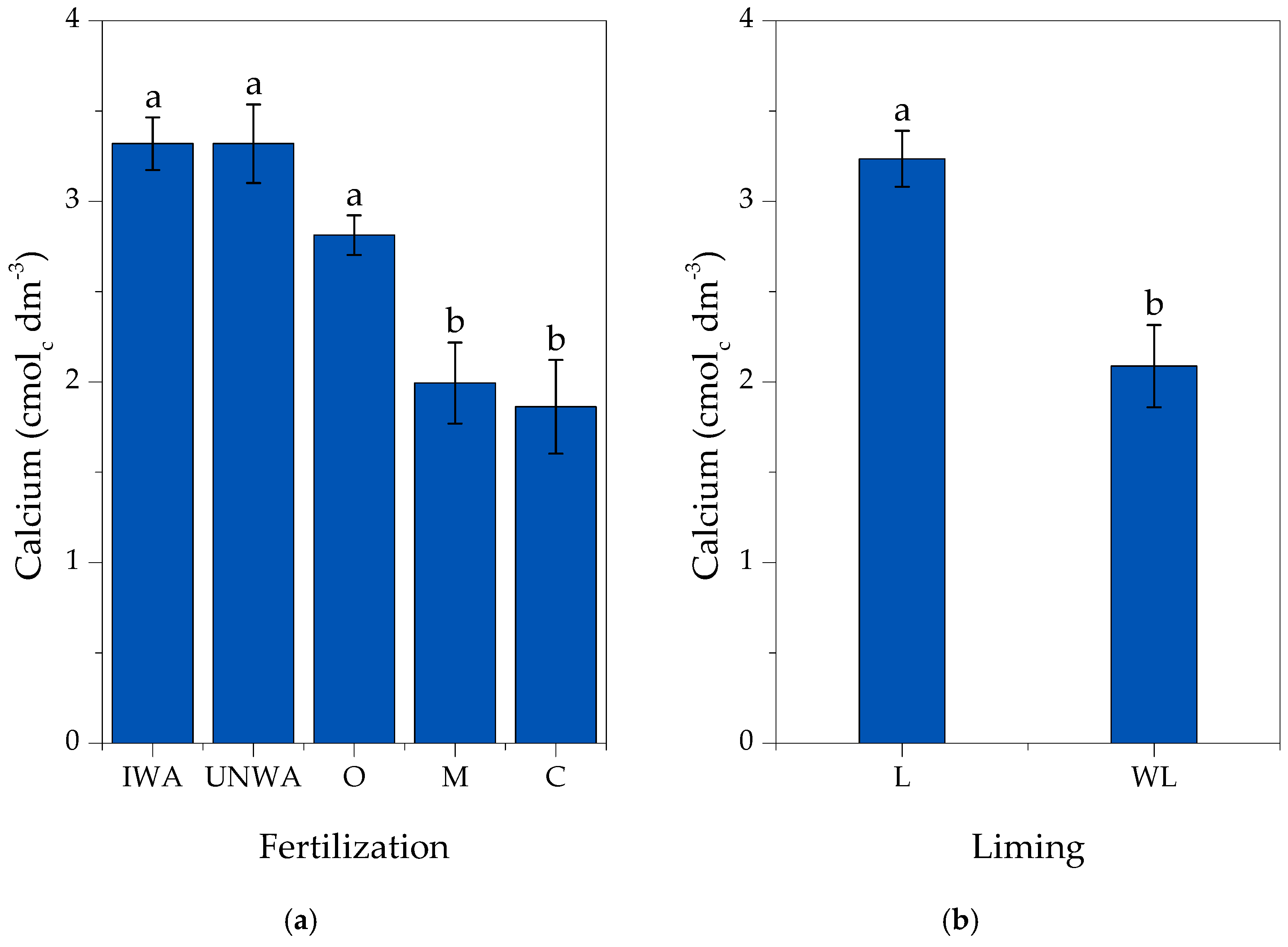


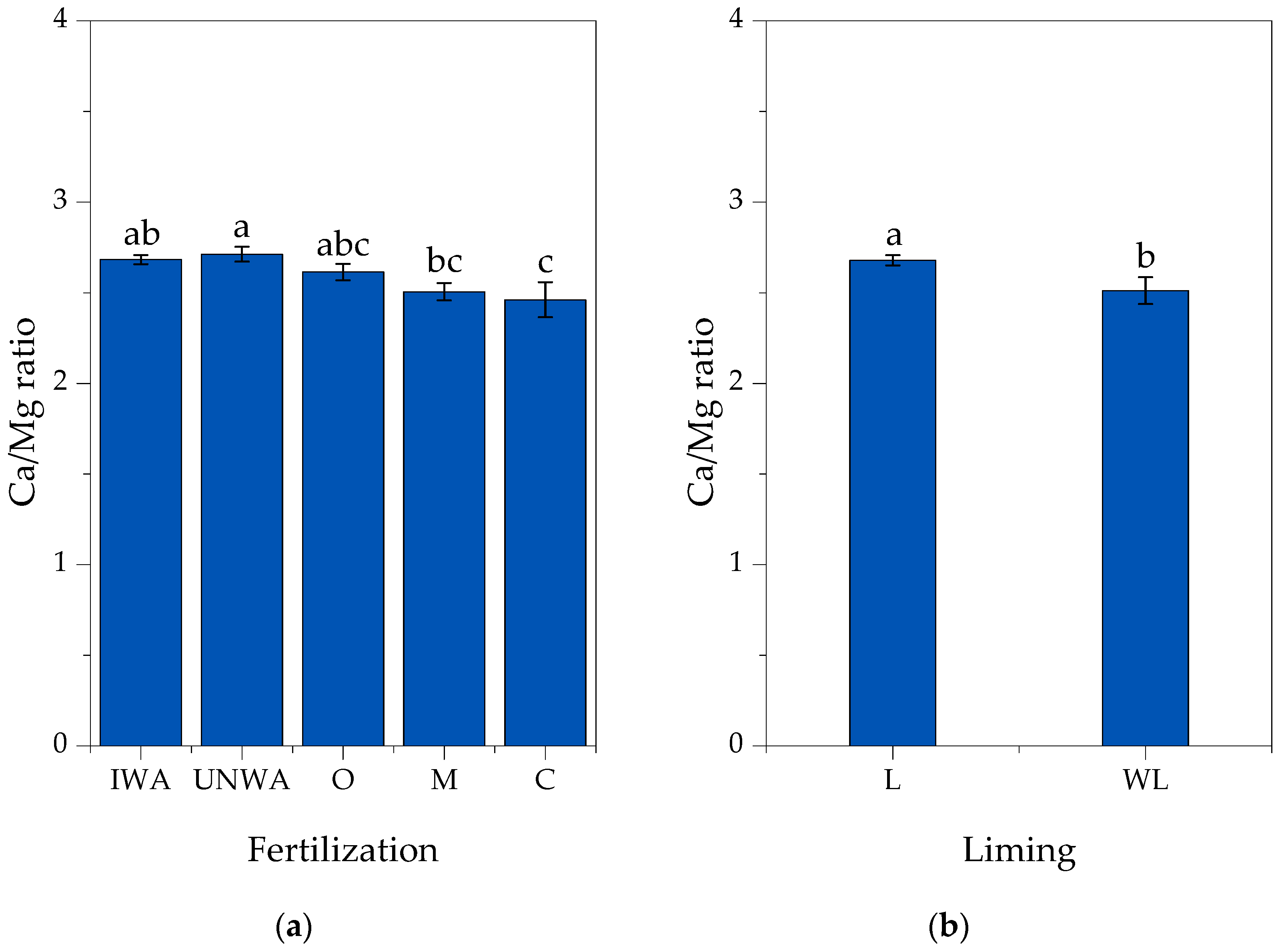
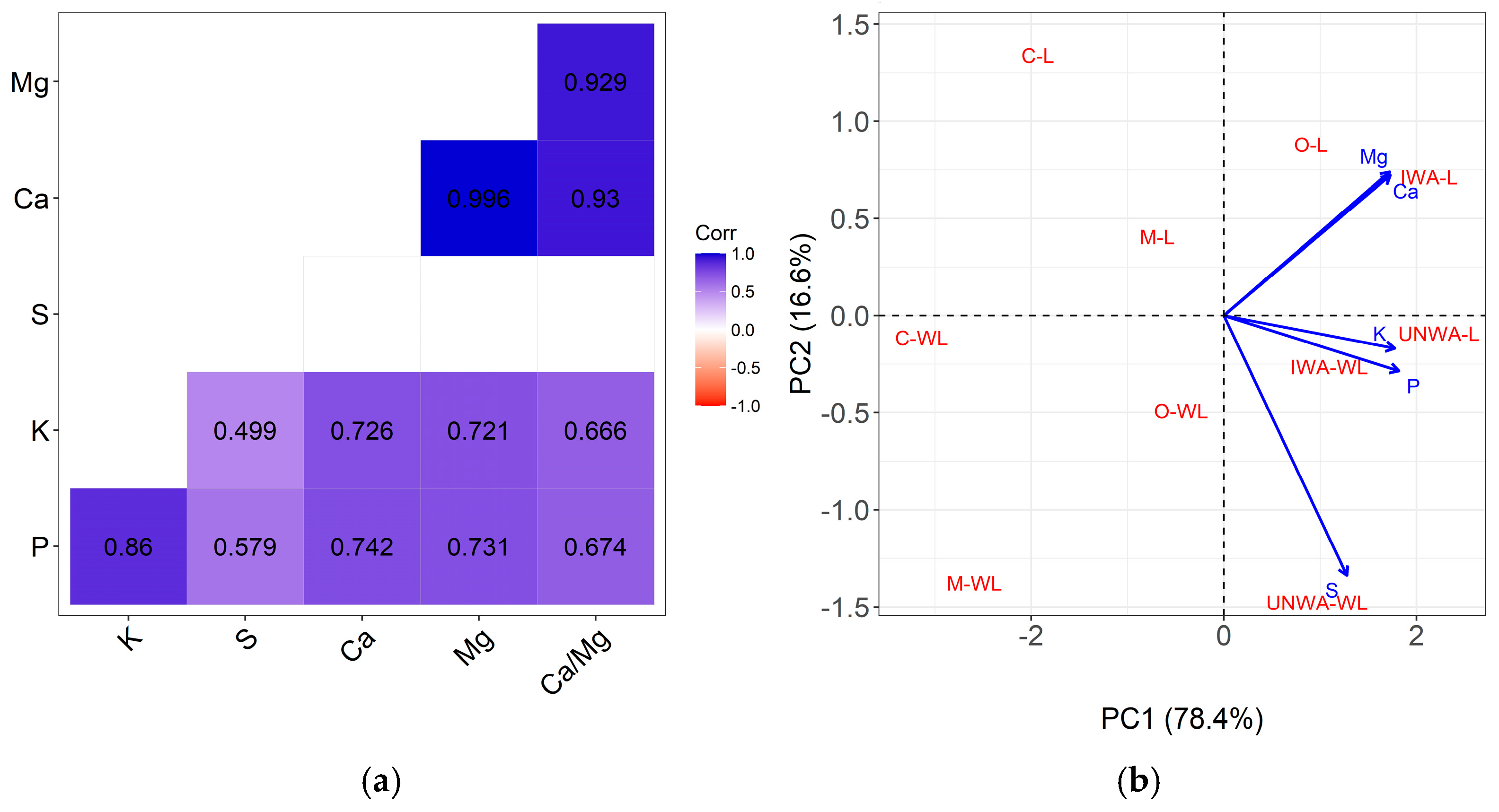
| pH | P | K | S | Ca | Mg | Al | H + Al | CEC | SB | OM |
| CaCl2 | ------------mg kg−1------------ | --------------------------------cmolc dm−3-------------------------------- | g kg−1 | |||||||
| 4.30 | 1.5 | 18.0 | 2.0 | 0.5 | 0.2 | 0.6 | 4.8 | 5.6 | 0.8 | 21.3 |
| V | m | B | Cu | Fe | Mn | Zn | Clay | Silt | Sand | |
| ------------%------------ | ------------------------mg kg−1------------------------- | ----------------g kg−1---------------- | ||||||||
| 13.5 | 44.4 | 0.15 | 0.2 | 64.0 | 21.8 | 0.7 | 455 | 100 | 445 | |
| pH | N | P2O5 | K2O | Ca | Mg | SO4 | B | Cu | Fe | Mn | Zn | CaO | MgO |
|---|---|---|---|---|---|---|---|---|---|---|---|---|---|
| CaCl2 | --------------------------------------------------------------------%------------------------------------------------------------------- | ||||||||||||
| 10.97 | 0.49 | 0.79 | 3.25 | 4.96 | 4.20 | 0.60 | 0.04 | 0.01 | 0.72 | 0.04 | 0.02 | 9.10 | 6.50 |
| Treatments | P * | P # | K * | K # | S * | S # | Ca * | Ca ## | Mg * | Mg ## |
|---|---|---|---|---|---|---|---|---|---|---|
| --------------------------------mg dm−3--------------------------------- | ----------------cmolc dm−3------------------ | |||||||||
| IWA (L) | 63.5 | Very high | 255.0 | Very high | 38.8 | High | 3.6 | High | 1.34 | High |
| IWA (WL) | 57.3 | High | 235.6 | Very high | 47.0 | High | 3.0 | High | 1.13 | High |
| UNWA (L) | 63.0 | Very high | 258.0 | Very high | 61.7 | High | 3.7 | High | 1.35 | High |
| UNWA (WL) | 53.0 | High | 243.6 | Very high | 76.2 | High | 2.8 | High | 1.08 | High |
| O (L) | 51.2 | High | 211.3 | High | 28.2 | High | 3.4 | High | 1.26 | High |
| O (WL) | 36.9 | High | 183.8 | High | 40.7 | High | 2.2 | Medium | 0.90 | Medium |
| M (L) | 32.1 | High | 64.9 | Medium | 35.3 | High | 2.8 | High | 1.08 | High |
| M (WL) | 22.4 | Medium | 48.7 | Low | 42.5 | High | 1.1 | Low | 0.47 | Medium |
| C (L) | 5.0 | Very low | 76.8 | Medium | 8.9 | Medium | 2.5 | High | 0.98 | High |
| C (WL) | 2.5 | Very low | 56.3 | Low | 13.2 | High | 1.1 | Low | 0.48 | Medium |
| Average pH (CaCl2) (30 DAS) | Soil acidity # | Average pH (CaCl2) (185 DAS) | Soil acidity # | |||||||
| 6.89 | Very low | 5.44 | Mean | |||||||
Disclaimer/Publisher’s Note: The statements, opinions and data contained in all publications are solely those of the individual author(s) and contributor(s) and not of MDPI and/or the editor(s). MDPI and/or the editor(s) disclaim responsibility for any injury to people or property resulting from any ideas, methods, instructions or products referred to in the content. |
© 2025 by the authors. Licensee MDPI, Basel, Switzerland. This article is an open access article distributed under the terms and conditions of the Creative Commons Attribution (CC BY) license (https://creativecommons.org/licenses/by/4.0/).
Share and Cite
Meneghetti, L.A.M.; Bonfim-Silva, E.M.; Araújo da Silva, T.J.; de Oliveira, N.P.R.; Costa Custódio, A.S.; Campos e Silva, I.A.; Bonfim-Silva, T.H.; Rocha, R.A.d.S.; Schlichting, A.F.; Guimarães, S.L.; et al. Effects of Organic, Organomineral, and Mineral Fertilization on Soil Macronutrients in Chrysanthemum Cultivar Singelo Cultivation. Horticulturae 2025, 11, 567. https://doi.org/10.3390/horticulturae11060567
Meneghetti LAM, Bonfim-Silva EM, Araújo da Silva TJ, de Oliveira NPR, Costa Custódio AS, Campos e Silva IA, Bonfim-Silva TH, Rocha RAdS, Schlichting AF, Guimarães SL, et al. Effects of Organic, Organomineral, and Mineral Fertilization on Soil Macronutrients in Chrysanthemum Cultivar Singelo Cultivation. Horticulturae. 2025; 11(6):567. https://doi.org/10.3390/horticulturae11060567
Chicago/Turabian StyleMeneghetti, Luana Aparecida Menegaz, Edna Maria Bonfim-Silva, Tonny José Araújo da Silva, Niclene Ponce Rodrigues de Oliveira, Alisson Silva Costa Custódio, Ivis Andrei Campos e Silva, Tallys Henrique Bonfim-Silva, Rosana Andreia da Silva Rocha, Alessana Franciele Schlichting, Salomão Lima Guimarães, and et al. 2025. "Effects of Organic, Organomineral, and Mineral Fertilization on Soil Macronutrients in Chrysanthemum Cultivar Singelo Cultivation" Horticulturae 11, no. 6: 567. https://doi.org/10.3390/horticulturae11060567
APA StyleMeneghetti, L. A. M., Bonfim-Silva, E. M., Araújo da Silva, T. J., de Oliveira, N. P. R., Costa Custódio, A. S., Campos e Silva, I. A., Bonfim-Silva, T. H., Rocha, R. A. d. S., Schlichting, A. F., Guimarães, S. L., Koetz, M., Santos, D. d. A. T., Guedes, P. O. A. d. S., & Silva, P. F. d. (2025). Effects of Organic, Organomineral, and Mineral Fertilization on Soil Macronutrients in Chrysanthemum Cultivar Singelo Cultivation. Horticulturae, 11(6), 567. https://doi.org/10.3390/horticulturae11060567






